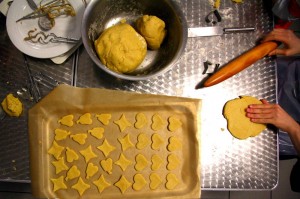
It’s that time of the year again—the time of pomegranates, peanuts, and these tiny baby oranges that seem to have a thousand different names, which has so far led to quite a few heated lunch break discussions.
December has started, and what would have been a better way to begin it than with a Christmas Baking Session?
Enthusiastic members of the administration and the student body gathered in the cafeteria to spend several hours of excessive cookie baking time together, while others stopped by just at the right time to appreciate the delicious baking results.
During the previous weeks, many students and members of the faculty had sent their traditional baking recipes to Stefan, who then made sure all the various ingredients would be provided. A mountain of yeast, saffron, flour, vanilla sugar, nutmeg, cinnamon, eggs, confectioner’s sugar, ginger, melted butter, cream, honey and baking powder piled up on the middle of the table—it didn’t take long until we all had been turned into dough-covered cookie monsters.
Since there were several different recipes to work with, participants split up into groups. A few members of administration had brought their children along, so the task of cutting out cookies was taken care of. Katharina was sculpting a delicate Christmas tree out of dough and Zoltan was stuck up to his elbows in a bowl of Hungarian honey and cinnamon dough, while a few others were already waiting in front of the oven for the first batch.
The only project that hadn’t been started yet, seemed to scream our names: Ginger Creams—a recipe from Ryan Plumley’s mother. After putting on aprons, to get at least some sort of protection from the sweet stickiness of the cookie dough, we were ready to face the challenge. But where to start?
Collecting the ingredients that were spread all over the room turned out to be a good opportunity to learn a few necessary words in German: shortening, molasses, nutmeg and cloves had to be translated in order to identify the right ingredients to work with. With all the busy bees running around the room, this proved to be quite difficult, but eventually we succeeded in having all the items ready.
Because the recipe was American, we stuck to using cups as measuring tools and were surprised about the huge mass of dough that miraculously appeared in the bowl. As soon as the problem of properly cracking the eggs had been overcome as well, the dough was finally ready for the spices. The recipe told us to use four tablespoons of ginger, but they might have turned into six or seven in practice.
With the dough spiced up, we began to get very excited for the results. Next, it was time to shape the little delicacies on the baking tray, but while the recipe said to drop them by teaspoonfuls, we thought the bigger the better, and produced cookies of monstrous sizes.
Meanwhile, the first butter biscuits had cooled down and were greatly appreciated by the baking community, along with home-made Glühwein. According to our schedule, we were still supposed to make the icing for the Ginger Creams and got great tips from Katharina on how to do it. The icing itself turned out to be almost irresistibly delicious, and we made it even fancier by stirring in red and blue food colouring.
I guess that the children in us were coming through again that day, and I am sure that many of us were reminded of the good old days, when we had gaps between our teeth and cookie dough smeared across our faces. A joyful feeling was in the air, and more and more people arrived to “see what was going on in the cafeteria” after many classes had ended at 16:45.
I cannot point out enough, how great this afternoon with the ECLA family was, since it got us in the wintery Christmas mood and distracted us from the end-of-term workload. And the Ginger Creams? Spicy, buttery, red and blue deliciousness that didn’t survive the rush for too long.
by Johanna Fürst (AY’12, Austria)
